The Incredibly True Adventures of Gerda Wegener and Lili Elbe
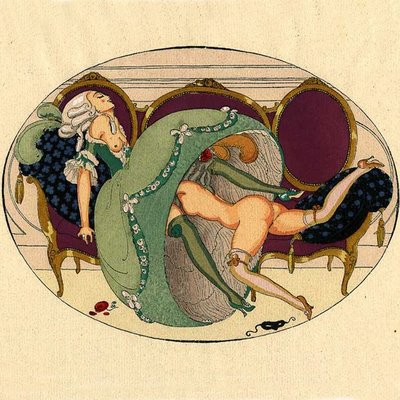
Gerda Wegener, Cuckoo, 1920. Note the fallen black mask on the floor: it repeats in many of Gerda’s erotic paintings.
This is the true story of turn-of-the-century lesbian romance, erotic Deco illustrations rife with harlequins and crinolines, the world’s first male-to-female sex reassignment surgery, and the 1950s pulp novel that brought it all to light.
The story begins one hundred years ago. In 1912, artist couple Gerda and Einar Wegener arrived in Paris, hoping for greater prosperity and freedom than their conservative hometown of Copengahen would allow. They checked into the Hôtel d’Alsace, where – they were shocked to learn – they had been placed into the very same room where Oscar Wilde had once died twelve years earlier. The couple spent the next few days reading Wilde’s works out loud to each other. The forbidden sexuality, transformation, beauty and tragedy in Wilde’s work was reflected in the couple’s following years together.

Gerda, left. Lili, right.
In Paris, Gerda quickly became well-known for her sensual, free-spirited illustrations. Her work often featured a mysterious beauty with a stylish short bob, full lips, and beguiling brown eyes. In 1913, the public was shocked to learn the identity of the mystery model: Gerda’s husband, Einar. Einar was transitioning to living life openly as woman named Lili Elbe.
Lili’s gender transformation began one evening years earlier when one of Gerda’s portrait subjects, actress Anna Larsen, was unable to show up for a sitting. Gerda jokingly suggested that Einar substitute for Anna, donning a pair of stockings and heels. It was a moment of awakening for Einar. In the years that followed, Lili become Gerda’s chief model.
Gerda’s artistic career soared, while Einar’s never really took off. Exhibitions of Gerda’s decadent drawings caused public outcry and riots. She drew fashion illustrations for Vogue, published art books (including one chronicling Casanova’s adventures), and threw wild parties at her expensive Paris studio, which she called “Les Arums.”
An unusual polyamorous relationship developed between Gerda, Einar and Lili. The couple would refer to Lili in the third person when she wasn’t there. “Let Lili come over,” Gerda would say. Living openly as a queer woman in Paris, it seemed that Gerda was more attracted to the lively, coquettish Lili than the despondent Einar. For his part, Einar noticed when he was in his male guise, he suffered from coughing spells and fits of depression. Meanwhile, when Lili came out, she was bright, hopeful and happy.
In 1930, Lili went to Germany to get the world’s first sex reassignment operation. A series of surgeries left Lili feeling reborn and rejuvenated. Her body felt younger, her skin softer, and her personality had changed more than ever before. Einar’s artistic drive was a casualty of the transformation. “I do not want to be an artist, but a woman,” Lili wrote. “Hence I must shut all artistic creation out of my life… because I cannot continue the work of the virile artist who was [Einar].”
Lili and Gerda returned to Copenhagen. Old friends did not recognize Lili. She could walk anonymously through the city, unremarked upon by women, and admired by men. But life wasn’t easy for her. When the couple held an art exhibit to help fund Lili’s surgeries, Lili’s paintings failed to sell after she was outed by the newspapers. She knew that she was an outsider. One day, at an art gallery, a woman approached her:
“Tell me, miss, don’t you think that the lady over there with the large feet and the necktie, who looks like a man, is Lili Elbe?”
“Yes,” answered Lili, “most decidedly that is she.”
By 1931, Gerda and Lili had separated amicably. Their marriage had been annulled by the King of Denmark, and both were seeing other people. Gerda married an Italian officer, while Lili had fallen in love with a young French painter.
Here, tragedy struck. Hoping to become a mother, Lili went in for one last surgery – the transplantation of a uterus. Many doctors of the era did not understand enough about reproductive anatomy to see why such a procedure would fail. Lili’s body rejected the organ, and she died two days later. [Addendum: Ian Baker writes, “Misunderstanding of reproductive anatomy is probably not why her surgery failed. Rather, anti-rejection medicine wasn’t around until the discovery of cyclosporine in the 1970s, and the first successful human organ transplant didn’t happen until 1980. It’s more a misunderstanding of the immune system that was a problem.” Thanks for the clarification, Ian! <3]
Gerda Wegener never recovered from Lili’s death. She divorced her husband “almost overnight” and isolated herself in a small rented Copenhagen flat. By then, her paintings had fallen out of fashion, and she was unable to produce work that followed the art trends of the time. The artist whose work had once caused riots in France now supported herself by drawing Christmas cards, which she sold for one Danish Krone apiece. The impoverished Gerda took to drinking and died alone in 1940.
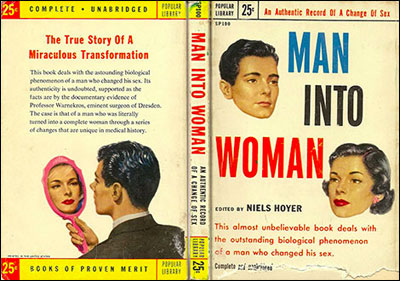
Man Into Woman, Lili’s memoir, republished in the 1950s.
Their story was forgotten until the second half of the last century until Lili Elbe’s memoir, “Man Into Woman,” was republished in the 50s as a pulp paperback with a sensationalistic cover. Author Jan Morris and tennis player Renee Richards both credit the book for inspiring them to transition. In their autobiographies, both women recount the magic moment in which pulled the dusty book off the shelf at a bookstore, and how much it meant to them.
Gerda, for her part, was rediscovered more than 40 years after her death, when some of her erotic watercolor paintings turned up at a Copenhagen junk shop in 1984. Although her work remains relatively obscure, it’s possible to find scans of many of her illustrations online. Old prints of hers still come up on Ebay (as, more rarely, does the work of Einar Wegener.)
In 2000, author David Ebershoff published a fictionalized account of Lili’s life titled “The Danish Girl.” The book is currently being made into a movie, though there’s been a high turnover of directors and actors attached to the project (at some point, “Let the Right One In” director Tomas Alfredson was at the helm – that would’ve been fantastic). Currently, Nicole Kidman and Rachel Weisz are slated to play Gerda and Lili, respectively. Weisz is great, but it would be more authentic to have a transgender actress or male actor playing Lili. How about Elijah Wood?
More on Gerda and Lili:
- 1933 Article about Gerda Wegener in the Milwaukee Times
- Comprehensive Book Review of “Man Into Woman”
- Einer Wegener – Papillon Gallery
- A Way of Looking at It: Biography of Gerda Wegener
- Rare photos of Gerda and Lili
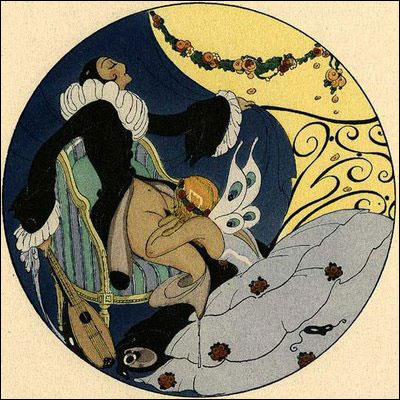
Gerda Wegener, Butterfly, 1920.
- Leaving a Trail: The Fetish Art of Franz van Bayros
- Some Hot Human-on-Centaur Action
- The Fantastical Fairy Tale Art of Sveta Dorosheva
- Hussar Ballad: Soviet Crossdressing Wartime Musical
- Jared Joslin: Stop, Look and Glisten
- I Blame Pierrot for Everything
- Sous La Glace
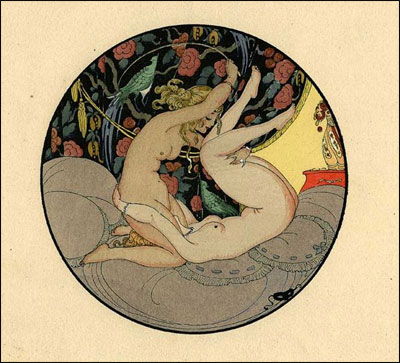
Gerda Wegener. Date unknown.
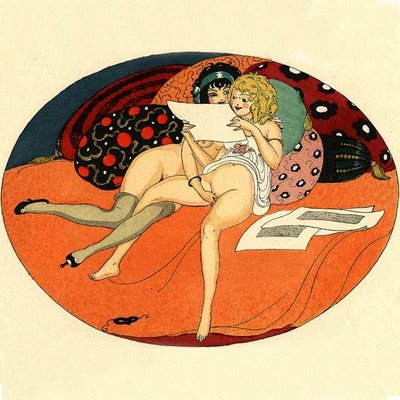
Gerda Wegener, Erotic Scene. Date unknown.
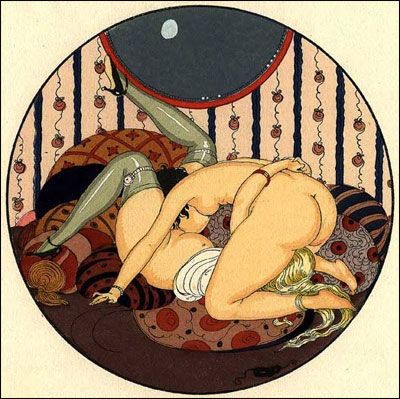
Gerda Wegener, Circling, Date unknown.
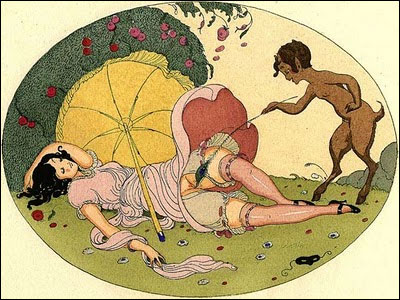
Gerda Wegener, Erotic Scene. Date unknown.
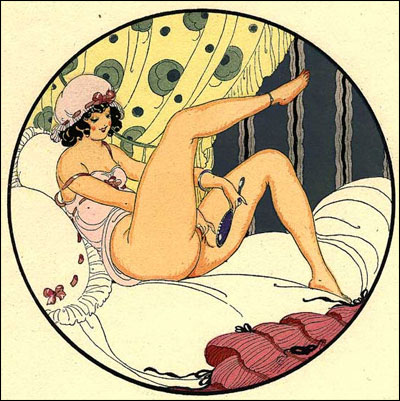
Gerda Wegener, There!, 1920
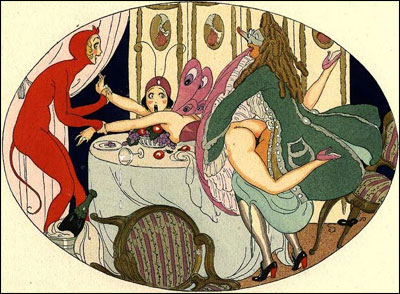
Gerda Wegener. Date unknown.

Gerda Wegener, Pan. Date unknown.

Gerda Wegener, Leda and the Swan. Date unknown.
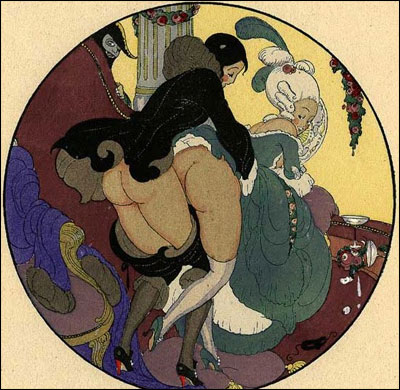
Gerda Wegener, Peeping Tom. 1920
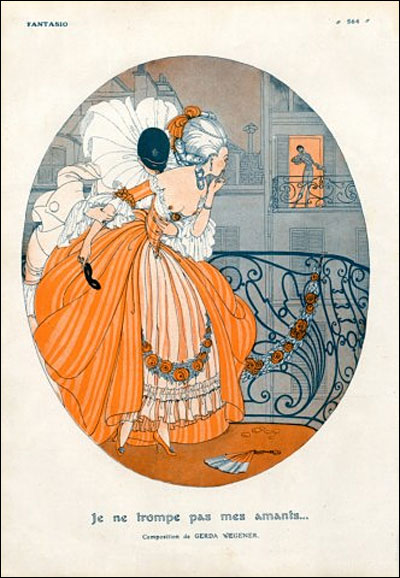
Gerda Wegener Pierrot Masquerade Ball, 1914.

Gerda Wegener. “A la diable”, revue civile et militaire. Illustration for La Baionnette. 1917.

Gerda Wegener. “A la diable”, revue civile et militaire. Illustration for La Baionnette. 1917.
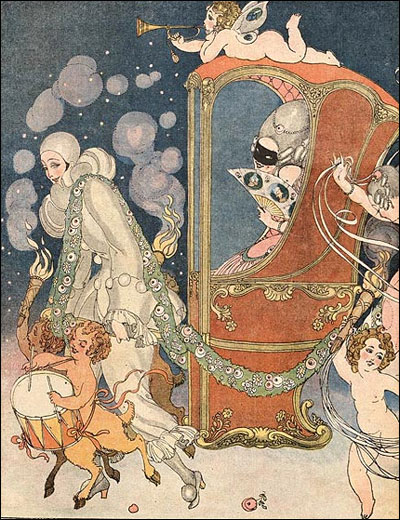
Gerda Wegener. Illustration for La Baionnette, 1919. Larger image here.
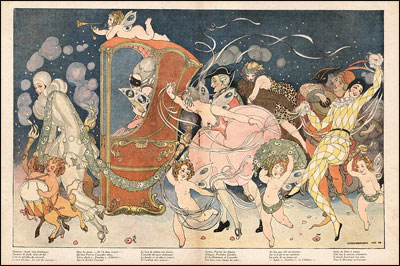
Gerda Wegener. Illustration for La Baionnette, 1919. Larger image here.
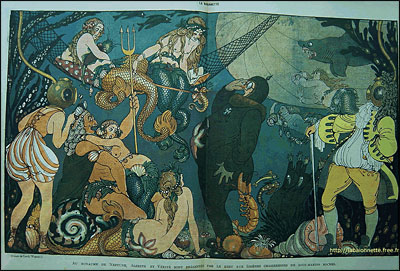
Gerda Wegener. “A la diable”, revue civile et militaire. Illustration for La Baionnette. 1917.
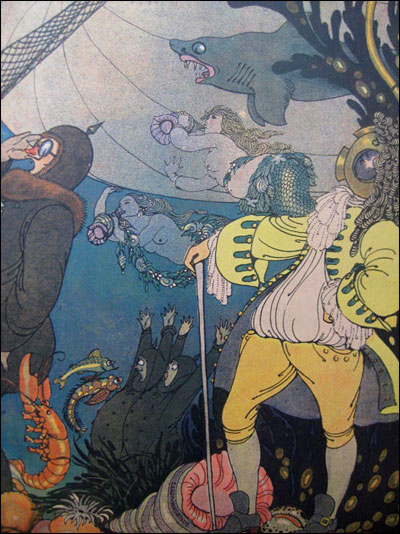
Gerda Wegener. “A la diable”, revue civile et militaire. Illustration for La Baionnette. 1917.

Gerda Wegener. Date unknown.
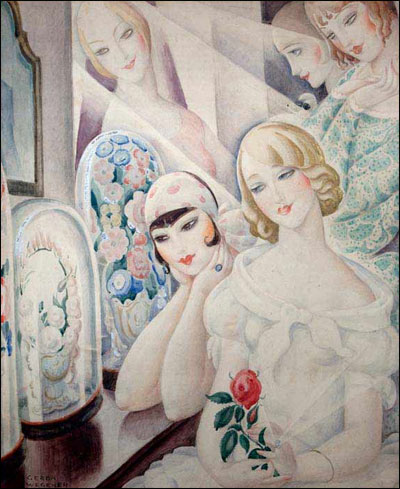
Gerda Wegener, Femme à la rose rouge, 1928.
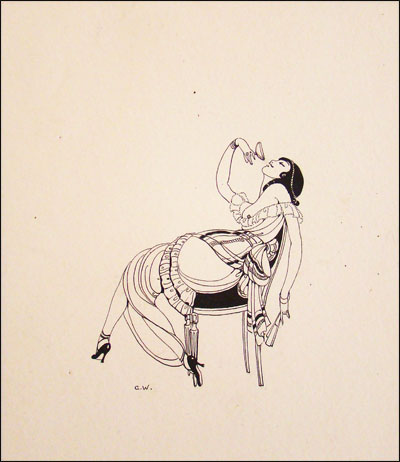
Gerda Wegener, The Last Drop, date unknown.
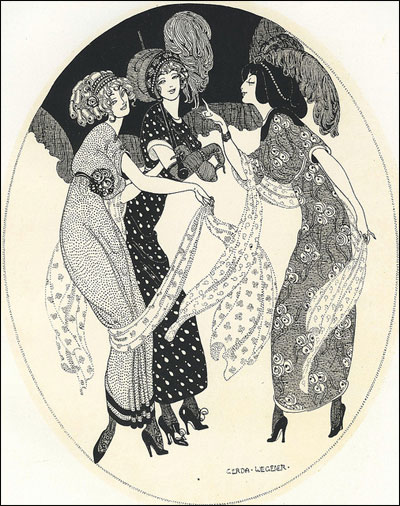
Gerda Wegener, The Three Graces, date unknown.
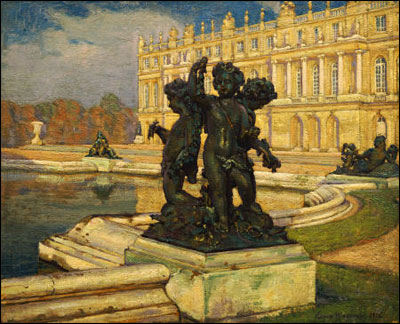
Einar Wegener, Versailles. 1916.
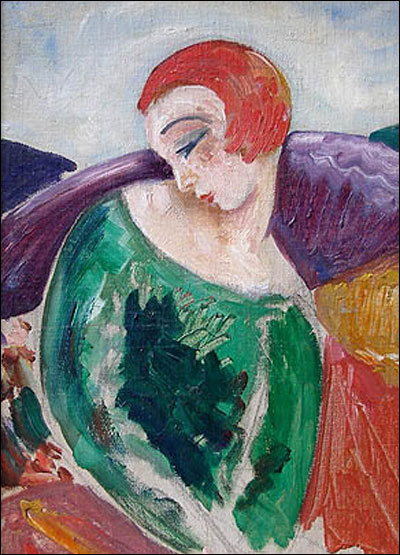
Einar Wegener, Portrait De Femme. 1923.

August 3rd, 2012 at 7:10 pm
[…] Coilhouse » Blog Archive » The Incredibly True Adventures of Gerda … […]
August 4th, 2012 at 3:18 am
Just a few sentences down I knew that this would be one of my favourite Coilhouse articles.
August 4th, 2012 at 8:33 am
> Weisz is great, but it would be more authentic to have a transgender actress or male actor playing Lili. How about Elijah Wood?
This sort of thing used to bug me, but after thinking about it for a while, I’ve decided I’m over it. Since the earliest films about trans women, cis women have played them (the earliest example I’ve found is 1972’s “I want what I want”, starring Anne Heywood). Trans women don’t really look more like cis men than they look like cis women, and I don’t know that a cis male actor could better represent the experience of trans femininity than a cis actress could.
Anyway, the intersection of “authenticity” and “transgender” is a terrifying, all-devouring fractal monster than only the bravest and most foolhardy dare behold.
August 4th, 2012 at 9:37 am
I’d never heard of this couple. Thanks so much for recalling their artistic, romantic, and surgical exploits.
August 4th, 2012 at 2:02 pm
[…] Coilhouse: The Incredibly True Adventures of Gerda Wegener and Lili Elbe Share this:TwitterFacebookLike this:LikeBe the first to like this. Leave a comment […]
August 5th, 2012 at 11:41 am
Amazing. Thanks for this fascinating and romantic story! Love Gerda’s art too. I can just imagine its scandalised reception in the 1920s.
August 6th, 2012 at 9:13 am
I adore this article! Thanks for sharing this mesmerizing real story. I will check my library to see if I can find more content. :)
August 14th, 2012 at 9:27 am
A very valuable contribution, thank you!
November 19th, 2012 at 6:57 am
simply splendid. This article speaks to me on so many different levels. Seeing as how i am a queer woman and artist. This has just inspired me greatly. Thank you. i am definitely going to explore the lives of Gerda, Einar, and Lili now that you have brought them to my attention.
One Love <3
November 20th, 2012 at 9:30 am
Fantastic, thank you for the information I have only seen one or two paintings by Gerda before and knew almost nothing about her and Einar.
July 19th, 2013 at 3:27 am
[…] and her transsexual husband Einar. I couldn’t improve upon its telling by the late, lamented Coilhouse, so if you want to know how two people can live in a menage à trois, click and read on. Oh, and […]